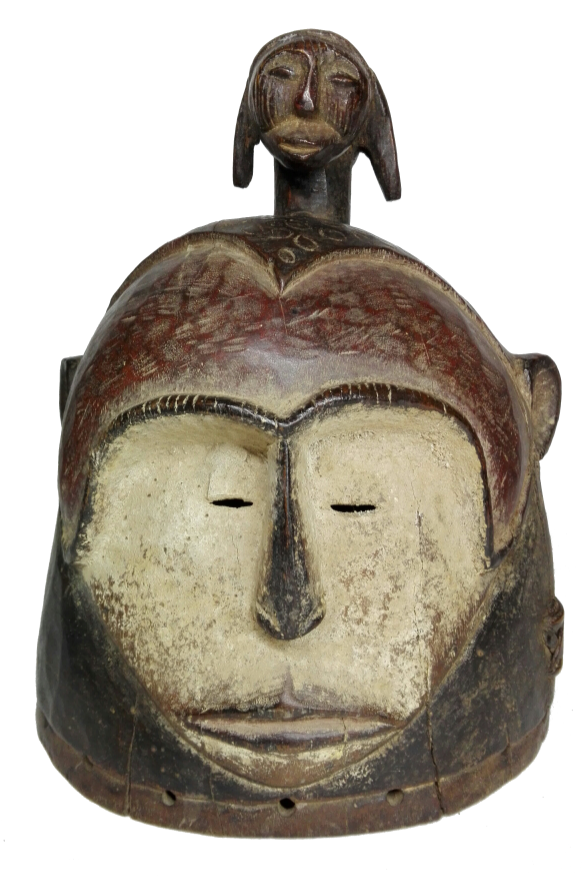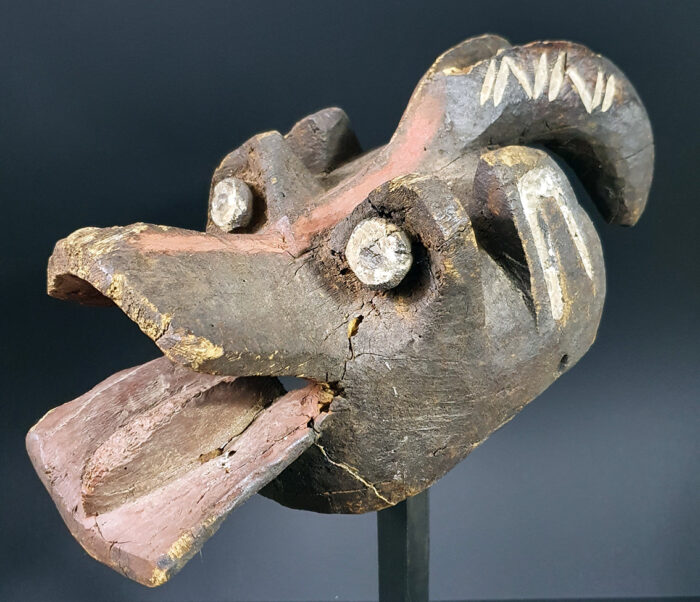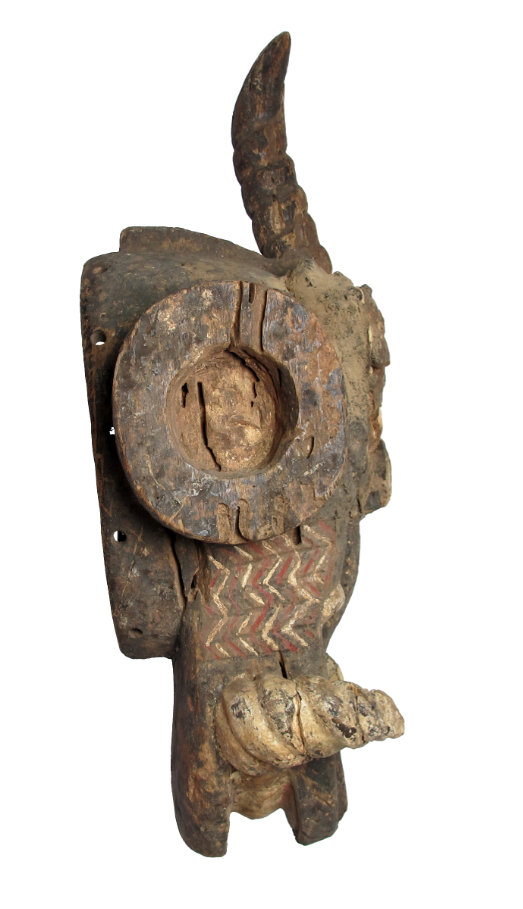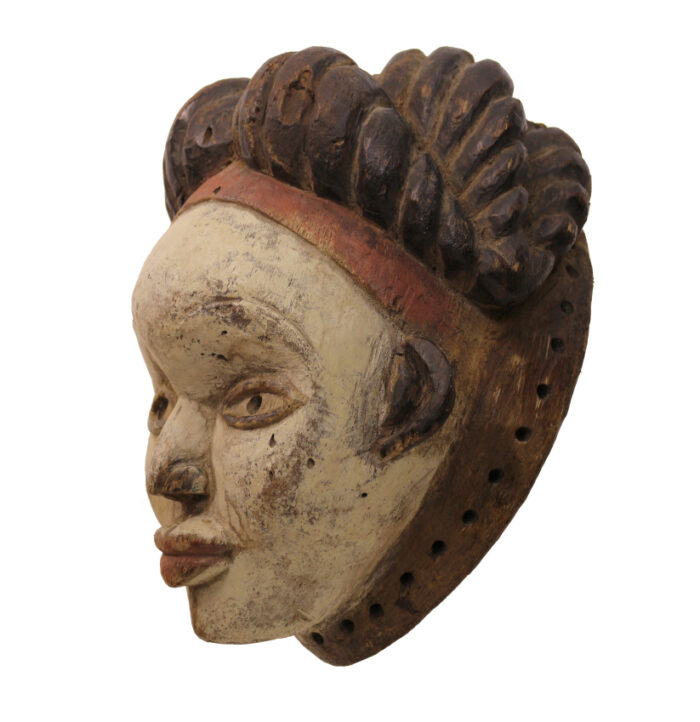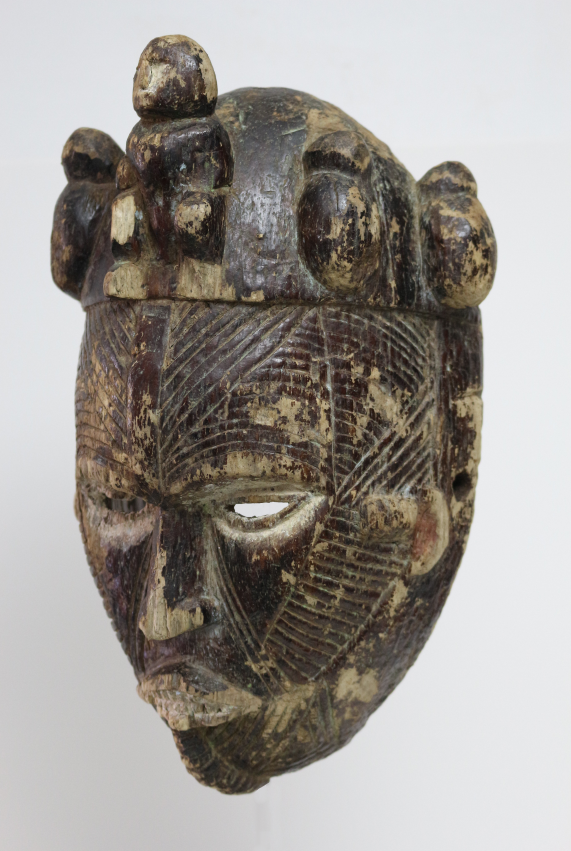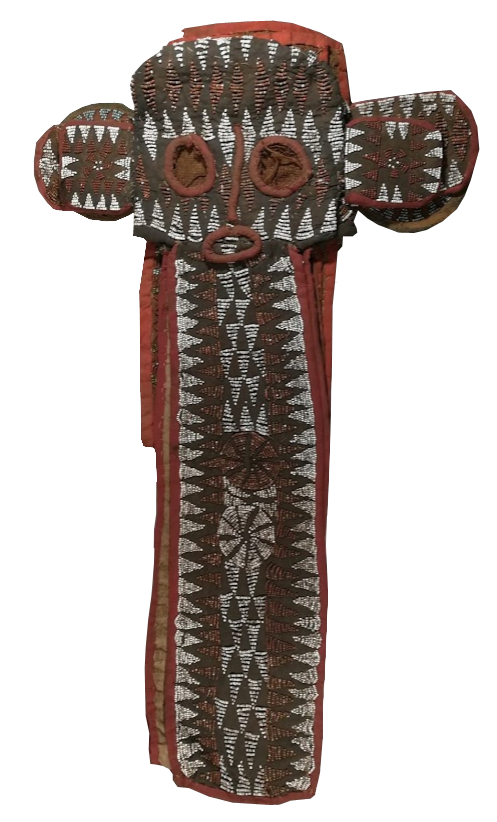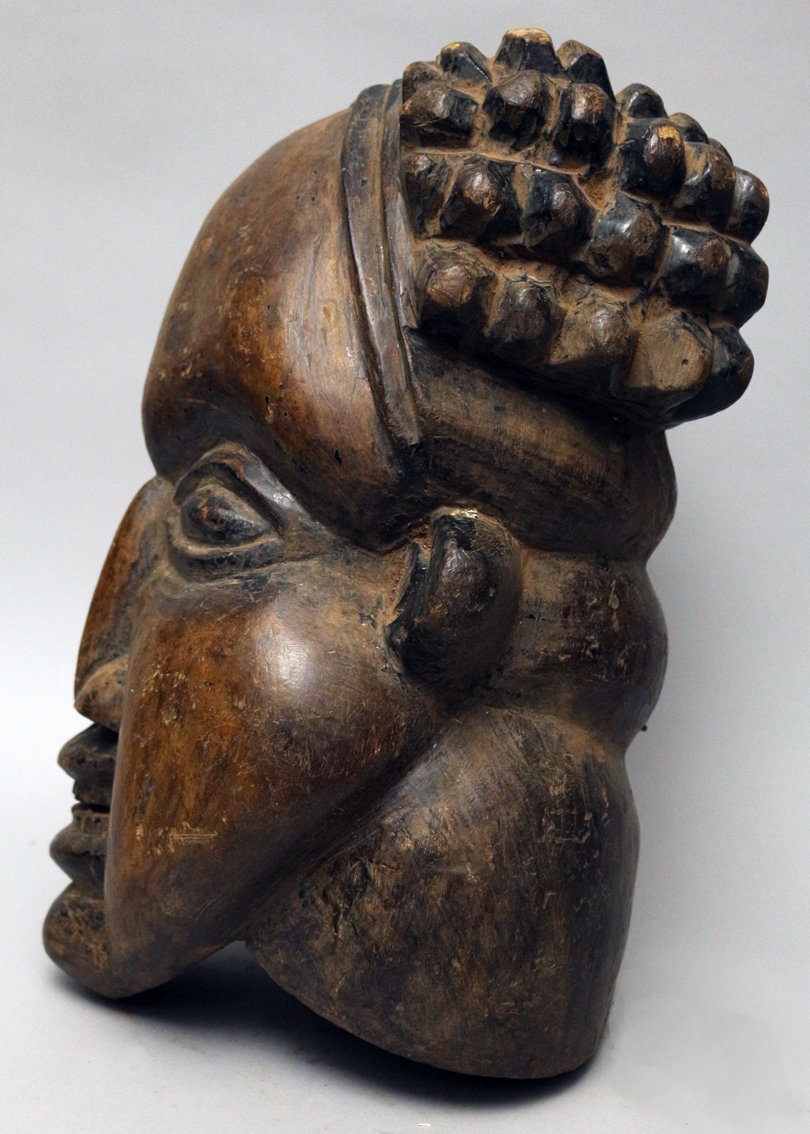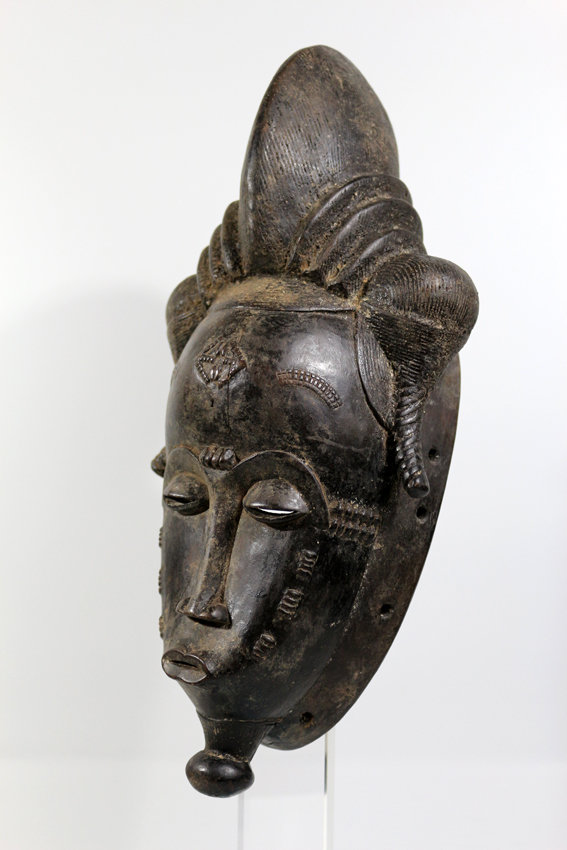-
Vue Rapide
Afrique. Important masque heaume Songye. On notera une jolie restauration indigène en agrafes de métal à l’arrière de la tête. La patine est est sombre, le casque surmonté d’une tête janus. H. 28cm. (Afrique, Art africain, Civilisation et ethnies).
-
Vue Rapide€1.200,00
Afrique. Exceptionnel masque Mambila (Nigéria).
Situé de part et d’autre de la frontière Nigéria-Cameroun, le peuple Mambila possédait des masques zoomorphes appelé “Sua-ga” appartenant aux associations masculines et féminines. comme dans la statuaire, l’emploi de pigments naturels souligne avec force les reliefs de la sculpture et possède une symbolique propre. Appartenant à la grande tradition des masques horizontaux évoquant le buffle ou l’antilope, on les retrouve en usage chez les peuples sahéliens du Mali jusqu’au Cameroun.
-
Vue Rapide
Masque Mambila, Nigéria Afrique. Beau masque Mambila (Nigéria, Cameroun). Bois tendre érodé. Ce type de masque est notamment convoqué à danser pour les réjouissances et les fêtes de semailles. Bois, kaolin, pigments. H. 35,5cm. ( Afrique, Art africain, Civilisation et ethnies).
-
Vue Rapide€350,00
Exceptionnel rare et ancien masque du Nigéria. Accidents, manques et usures visibles. H. 51cm. (Afrique, Art africain, Civilisation et ethnies).
-
Vue Rapide
Masque Punu, Gabon Afrique. Important masque Punu. Une belle coiffe ouvragée, une très bellle expression sereine font de ce masque une pièce exceptionnelle réservée à des dignitaire de haut rang. H. 33,5cm. ( Afrique, Art africain, Civilisation et ethnies).
-
Vue Rapide
Afrique. Important Masque PUNU Lumbo, Gabon. Doté d’une importante coiffe sommitale, ce masque est un exceptionnel artéfact de l’art Punu. Approx. 35CM. (Afrique, Art africain, Civilisation et ethnies).
-
Vue Rapide
Afrique. Masque Téké très érodé. Les Teke – ou Téké – sont des Bantous d’Afrique centrale répartis, pour l’essentiel de leur population, au sud, au nord et centre de la République du Congo. Bois, pigments. H. 30,5cm. (Afrique, Art africain, Civilisation et ethnies).
-
Vue Rapide
Masque zoomorphe à cornes Afrique. Beau masque zoomorphe à cornes. Probablement issu des régions limitrophes aux Ibibios (Nigéria). Les yeux sont surmontés de kaolin rafraîchi et les cornes se rejoignent à leurs sommets conférant à l’ensemble les attributs caractéristiques d’un masque initiatique de société secrète. Bois, Caolin. H. 38cm – (Afrique, Art africain, Civilisation et ethnies).
- Vue Rapide
-
Vue Rapide€2.100,00
The Bamileke are a people of Central Africa, coming from Cameroon (West region) in the Grassland region where the Bamoun, Tikar also live, close to them by their common ancestors, their neighboring social structures and their languages. .
The work of D. Toukam (“History and anthropology of the Bamileke people”, Paris, L’Harmattan, 2010 and 2016; …) conclude that the Bamileke would most likely come from the Baladis of ancient Egypt (natives of Upper -Egypt). In Egypt, the current Feelahins / Copts are largely recognized as Baladis converted by force, but still retaining huge parts of their ancestral culture. Departing from Upper Egypt in the 9th century AD, the Baladis-Bamileke arrived in the Tikar region in the 12th century. They were neighbors of the Tikar, but were never descendants of Tikar, contrary to popular belief.
The Bamilekes are, in spiritual matters, of great complexity The whole of their traditional religious organization is composed of initiation practices, meditations and rituals.
Their production of objects linked to their different cults has been very rich and some cults are still in progress today by exploiting ancient masks kept in certain chiefdoms or with certain notables or pieces called ” replacement “created to replace old worn, too damaged parts or because the use was limited in time.
-
Vue Rapide€3.200,00
Cameroon, Bamiléké – Dance mask
The Bamileke are a people of Central Africa, coming from Cameroon (West region) in the Grassland region where the Bamoun, Tikar also live, close to them by their common ancestors, their neighboring social structures and their languages. .
The work of D. Toukam (“History and anthropology of the Bamileke people”, Paris, L’Harmattan, 2010 and 2016; …) conclude that the Bamileke would most likely come from the Baladis of ancient Egypt (natives of Upper -Egypt). In Egypt, the current Feelahins / Copts are largely recognized as Baladis converted by force, but still retaining huge parts of their ancestral culture. Departing from Upper Egypt in the 9th century AD, the Baladis-Bamileke arrived in the Tikar region in the 12th century. They were neighbors of the Tikar, but were never descendants of Tikar, contrary to popular belief.
The Bamilekes are, in spiritual matters, of great complexity The whole of their traditional religious organization is composed of initiation practices, meditations and rituals.
Their production of objects linked to their different cults has been very rich and some cults are still in progress today by exploiting ancient masks kept in certain chiefdoms or with certain notables or pieces called ” replacement “created to replace old worn, too damaged parts or because the use was limited in time.
-
Vue Rapide€1.600,00
Ivory Coast, Baoulé mask
The Baoulés (Ba Ou li) are a people of Côte d’Ivoire, living mainly in the center of the country, near the cities of Bouaké and Yamoussoukro. They represent around 23% of the country’s population (around 3,943,667 individuals), which makes the Baoulés the first ethnic group in the country, ahead of the Betes and the Senoufos, who constitute the country’s second and third ethnic groups respectively. The Baoulés are part of the Akan group and are from neighboring Ghana. They settled in Ivory Coast in the 18th century, guided by Queen Abla Pokou. The name Baoulé comes from the sacrifice, by Queen Pokou, of one of her sons in order to cross a river, while she was leading the flight of her people from Ghana: ba ou li (the child is dead). The Baoulés settled between the Bandama and Comoé rivers.
***
Ivory Coast, Baule Mask
The Baoulés (Ba Ou li) are a people of Ivory Coast, living mainly in the center of the country, near the cities of Bouaké and Yamoussoukro. They represent about 23% of the population of the country (about 3,943,667 individuals) which makes Baoulés the first ethnic group of the country ahead of Betes and Senoufos which respectively constitute the second and third ethnic group of the country. The Baoulés are part of the Akan group and come from neighboring Ghana. They settled in Ivory Coast in the eighteenth century, guided by Queen Abla Pokou. The name Baoulé comes from the sacrifice, by queen Pokou, of one of her sons to cross a river, while she led the flight of her people from Ghana: ba or li (the child is dead). The Baoulés settled between the rivers Bandama and Comoé.
***
Elfenbeinküste, Baule-Maske
Die Baoulés (Ba Ou li) sind ein Volk der Elfenbeinküste, die hauptsächlich in der Mitte des Landes leben, in der Nähe der Städte Bouaké und Yamoussoukro. Sie repräsentieren etwa 23% der Bevölkerung des Landes (etwa 3 943 667 Personen), was Baoulés zur ersten ethnischen Gruppe des Landes vor Bêtes und Senoufos macht, die die zweite bzw. dritte ethnische Gruppe des Landes bilden. Die Baoulés gehören zur Akan-Gruppe und kommen aus dem benachbarten Ghana. Sie ließen sich im 18. Jahrhundert in der Elfenbeinküste unter der Führung von Königin Abla Pokou nieder. Der Name Baoulé kommt von der Opferung eines ihrer Söhne durch Königin Pokou, um einen Fluss zu überqueren, während sie die Flucht ihrer Leute aus Ghana führte: ba oder li (das Kind ist tot). Die Baoulés ließen sich zwischen den Flüssen Bandama und Comoé nieder.
